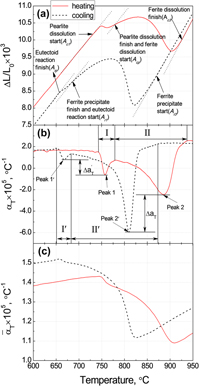Crossref Citations
This article has been cited by the following publications. This list is generated based on data provided by
Crossref.
Fang, Han
Wong, M B
and
Bai, Yu
2017.
Heating rate effect on the thermophysical properties of steel in fire.
Journal of Constructional Steel Research,
Vol. 128,
Issue. ,
p.
611.
Efremenko, V.G.
Chabak, Yu G.
Shimizu, K.
Lekatou, A.G.
Zurnadzhy, V.I.
Karantzalis, A.E.
Halfa, H.
Mazur, V.A.
and
Efremenko, B.V.
2017.
Structure refinement of high-Cr cast iron by plasma surface melting and post-heat treatment.
Materials & Design,
Vol. 126,
Issue. ,
p.
278.
Liu, Tao
Long, Mujun
Fan, Helin
Chen, Dengfu
Chen, Huabiao
Duan, Huamei
Jiang, Wenxiang
and
He, Wenjie
2018.
Dilatometric determination of four critical temperatures and phase transition fraction for austenite decomposition in hypo-eutectoid steels using peak separation method.
Journal of Materials Research,
Vol. 33,
Issue. 8,
p.
967.
Li, Jun-hui
Wang, Hong-hong
Luo, Qiang
Li, Li
Sun, Chao
and
Misra, R. D. K.
2019.
Correlation between microstructure and impact toughness of weld heat-affected zone in 5 wt.% manganese steels.
Journal of Iron and Steel Research International,
Vol. 26,
Issue. 7,
p.
761.
Skowronek, Adam
Grajcar, Adam
Kozłowska, Aleksandra
Janik, Aleksandra
Morawiec, Mateusz
and
Petrov, Roumen H.
2022.
Temperature-Dependent Microstructural Evolution of Al-Rich Medium-Mn Steel During Intercritical Annealing.
Metallurgical and Materials Transactions A,
Vol. 53,
Issue. 8,
p.
3012.
Zhao, Bo
Xia, Min
and
Ge, Chang-Chun
2022.
Study on microstructure, phase transformation behavior of T15 high-speed steel and the effect of adding REEs.
Metallurgical Research & Technology,
Vol. 119,
Issue. 5,
p.
525.
Jeong, Chang-Gon
Trang, T.T.T.
Woo, Youngyun
Yoon, Eun Yoo
Lee, Youngseon
and
Heo, Yoon-Uk
2023.
Effect of cooling rate on the final microstructure and tensile property in an Fe–Mn–Si–C-based multiphase TRIP steel.
Materials Science and Engineering: A,
Vol. 887,
Issue. ,
p.
145696.
Li, Xingzhen
Fan, Jie
Chen, Yalan
Xie, Xin
Liu, Chunli
Yin, Yuqin
Kou, Jixiong
Wu, Lei
and
Chen, Zhenbin
2023.
The structure and performance study of PP random impact resistance copolymer.
Polymer Bulletin,
Vol. 80,
Issue. 3,
p.
2637.
Wang, Lu
and
Wang, Shaoyang
2023.
Study on Austenite Transformation and Growth Evolution of HSLA Steel.
Materials,
Vol. 16,
Issue. 9,
p.
3578.
Liu, Changbo
Sun, Dongyun
Fang, Qiwen
Wang, Jianjun
Gao, Xiaojun
Zhang, Xinyao
Li, Guangsheng
Feng, Xiaoyong
Yang, Zhinan
and
Zhang, Fucheng
2024.
Effect of initial microstructure on microstructure and properties of bainitic steels achieved by rapid heat treatment.
Materials Science and Engineering: A,
Vol. 915,
Issue. ,
p.
147251.
Hossain, Md. Sarowar
Kanth, B. Rajini
and
Mukhopadhyay, P.K.
2024.
Enhancement of microstructure-based magnetic, electronic, and lattice contribution in a CoNiAl ferromagnetic shape memory alloy.
Surfaces and Interfaces,
Vol. 55,
Issue. ,
p.
105461.
